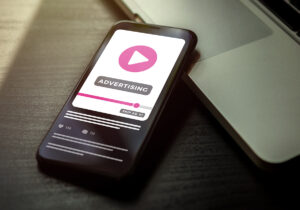Why you can’t afford to miss out on video advertising
June 5, 2025
Attention spans are shrinking and the demand for fast, engaging advertising is rising. Now is the time to leverage video advertising to connect with your customers in a more impactful, meaningful way. Captivate your audience with the story your video ads tell.

What is video advertising?
Video advertising is promotional content displayed before, during or after other video content on digital platforms. These platforms range from YouTube and over-the-top (OTT) services like Amazon Streaming and Twitch, to social media like Facebook, Instagram and Snapchat. Video ads are integrated directly into the content your audience is already consuming, making them hard to ignore.
Why video ads work
Video advertising is a valuable tool for businesses aiming to grow engagement, build brand awareness and connect with audiences through persuasive storytelling. When you combine visuals, sound and motion, video content captures attention and leaves a lasting impression.
If you’re not using video in your advertising strategy, these stats will change your mind.:
89% of viewers say a video convinced them to buy a product
91% of people want to see more video content from brands
Viewers spend 88% more time on websites with video
85% of US internet users watch online video content
66% of consumers find short-form videos most engaging
Types of video ads
Video ads are ideal when your business wants to reach a large audience and complement your other digital ad strategies. But to get the most out of your video advertising, you need to understand the different formats available:
In-Stream
Play before, during or after other videos on platforms like YouTube.
Available as skippable ads, bumper ads and non-skippable ads.
Outstream
Appears where there is no other video content like news articles or blogs.
They may autoplay when scrolled into view.
Social Media
Play across social media feeds next to organic posts.
It has a “Sponsored” label and a “Subscribe” button, and some are shoppable.
Native
Blend in with surrounding content on websites, social media and apps.
Fit in seamlessly with what viewers are already watching.
OTT
Similar to TV commercials and appear on streaming services.
Usually run 15-30 seconds and can’t be skipped.
Connected TV (CTV)
Plays during movies and shows on streaming services.
Usually are 15-30 seconds and served to a custom geography.
Pre Roll
Targets a custom audience on a variety of websites or apps.
Served to non-skippable platforms and optimized for completion rates.
Who do you reach?
Every minute your audience is connected on their device means brand exposure and sales potential for your business. The average screen time in the United States is 7 hours and 3 minutes per day. On average, 3 hours and 30 minutes are dedicated to mobile devices, while 3 hours and 34 minutes are spent on computers. Whether individuals are casually browsing or streaming content, your business has the opportunity to connect with a broad, diverse group of high-potential customers.
With advanced targeting capabilities, you reach viewers based on:
Demographics (age, gender, income)
Interests (hobbies, preferences)
Online behavior (purchase history, webpage viewing habits)

The pros of video advertising
Video advertising offers several benefits that make it a highly effective tool for you:
High engagement: Video storytelling captures attention and creates a memorable experience for your customer.
Detailed analytics: Track views, clicks and conversions to measure performance and make data-driven decisions to improve your advertising results.
Mobile-friendly: Delivering video ads optimized for mobile helps you reach a broader and more diverse audience.
Precision targeting: Connect with the customers who matter most by targeting based on demographics, interests and behaviors.
The cons of video advertising
While video advertising is effective, there are a few considerations to keep in mind:
Production time: From creative development and planning to execution, videos often take time to produce.
Slower loading times: Large video files may take longer to load and negatively impact user experience.
Ad blockers: Some viewers may avoid ads altogether with software or browser extensions, reducing the reach of your ads.
Limited interactivity: Some video ad formats offer limited click-through options, making direct conversions harder to track.

Tips for video advertising
Want better engagement and stronger results from your video advertising?
These tips will help you get more from your video ads:
Be mobile-friendly: Optimize for smartphones and tablets, as more and more people are watching video content on mobile devices.
Hook your audience: Grab attention within the first few seconds. The start of your video should hook viewers and encourage them to keep watching.
Make it short: Keep your video short and concise to maintain viewer engagement and get your message across quickly and efficiently.
Include a call-to-action: Tell viewers what to do next, such as “Shop Now,” “Learn More” or “Sign Up.”
Make it accessible: Add closed captions for inclusivity and to improve audience experience. Closed captions provide a text-based representation of the audio, making it easier for viewers to understand the content, even if they can’t or prefer not to listen to the audio.
How to get started with video ads
Ready to launch your video advertising campaign? Follow these key steps:
Define your goals: Clearly outline your business objectives. Are you building awareness, generating leads or driving sales?
Segment your audience: Use data from your store, website or app to create targeted audience groups. Identify characteristics, behaviors or interests to create your segments.
Personalize your message: Tailor your video content to each audience segment’s needs and interests. Personalization increases engagement and improves the effectiveness of your campaigns.
Choose the right platforms: Select the appropriate advertising platforms or networks that reach your target audience. Consider platforms like Google Ads, Facebook Ads Manager, LinkedIn Ads and Amazon Advertising based on their relevance and reach.
Track performance: Monitor metrics like view rates, clicks and engagement to understand audience behavior and optimize your ads.
Video advertising is a vital part of digital marketing. With the right strategy, targeting and creative approach, your business will connect with the right customers, increase conversions and drive real business growth.
Don’t forget to sign up for our newsletter or download our advertising whitepapers for more insights like these delivered straight to your inbox. And follow us on LinkedIn for more valuable advertising trends and tips.
